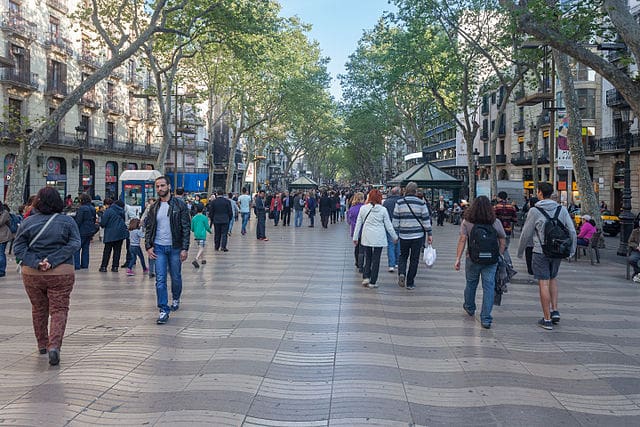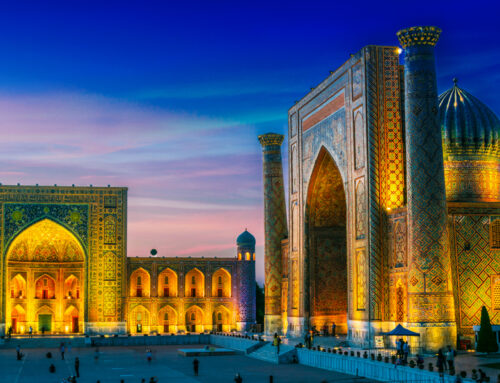The Changing Faces of The Ramblas, Barcelona’s Most Famous Street

The Ramblas: the changing face of Barcelona’s most famous street.
I remember the first time I walked down the Ramblas well. It was February 1998 and Barcelona’s most famous street was full of tourists and locals alike. There were silver-painted human statues, stock still until a coin clattered into their collection boxes, buskers of varying degrees of talent, and card tricksters keeping a keen eye out for the first sign of the law. Whether taking a stroll, people watching, or on their way elsewhere, the street was bustling with activity as people went about their business.
Four years later I was living in the city. Then I would often walk up the Ramblas in search of a taxi at the end of a night out while the pavements and cobblestones were hosed down. The streets were bustling with people, the sound of excited alcohol-fuelled chatter competing with the noise of the road sweepers. You’d need to tread carefully to avoid the worst of the water sprayed under pressure at the ground. It was often pretty crowded, but in those days walking the Ramblas wasn’t impossible.
A decade later things had got out of control. There were simply too many tourists stopping to watch the street entertainers. At some points along the Ramblas it often became impossible to move. Locals had abandoned it in droves and the street was simply no fun anymore.
It was clear something had to be done.
From Sewer to Street
The Ramblas was originally a dry stream bed lying outside the city walls. Used as a sewer, rainwater from nearby hills flowed down the Ramblas and into the sea. Its first use as a street dates to the 14th century when the walls were extended to include it with the city. Although really a continuous street running the 1.2 kilometres from Plaça Catalunya down to the harbour, the Ramblas can also be considered to be five separate streets. Locally it is known in the singular as la Rambla, or plurally as les Rambles (Catalan) or las Ramblas (Spanish).
Rambla de Canaletes
Here you’ll find Canaletes fountain where, since the 1930s, fans of FC Barcelona have gathered to celebrate after the club has won new silverware or won important matches. And if you drink from the fountain it is said you will return to the city one day.
Whether or not you get to see FC Barcelona play, if the club has won something important you can celebrate here with locals. Whenever a new La Liga or Champions League title is won this area gets packed and it can get more than a little rowdy.
Rambla dels Estudis
Once the site of the Jesuit University, for many years an open-air market for birds and other small animals was located here.
The noise could be deafening and sometimes you could see wild birds swoop in to steal food from those caged exotics. They lived in poor conditions though and, whenever we passed in the early hours, seemed to be locked into their stalls overnight. The market was always going to lose out to animal legislation and after years of legal battles it closed in 2010. It was long overdue.
Rambla de Sant Josep
Here you’ll find a flower market in the central walkway, hence the alternative name, Rambla de les Flors. As a hay fever sufferer I’ve never been a fan of this section of the Ramblas.
It is also home to the world famous Boqueria market, where you’ll find a wide range of foodstuffs. The market has become a tourist attraction in its own right for its colourful displays of fruit and vegetables.
Rambla dels Caputxins
This section gets its name from a former Capuchin monastery, but today is best known for the Liceu opera-house. In the middle of the paving you can also walk over a large mosaic by Joan Miró. The Catalan artist created it in 1976 close to his place of birth. Also just off Rambla dels Caputxins you’ll find Plaça Reial, a large square with tall palm trees and streetlamps designed by Antoni Gaudí. It is popular at night for its bars and music venues, but the restaurants are tourist traps.
Rambla de Santa Mònica
The bottom end of the Ramblas is named after St Monica’s convent, which is now used as an arts centre. You’ll also find a monument to Christopher Columbus constructed for the 1888 Barcelona Expo. Although Italian, Columbus was sponsored by Queen Isabella and King Ferdinand and he set off on his voyages to the New World from Spain.
Down here you’ll find an art market. You’ll also find the human statues, for which the Ramblas are famous. They weren’t always banished to this lower section of the Ramblas though.
The Tourist Problem
From the late 1990s onwards visitor numbers grew massively, helped by generation easyJet and the proliferation of low-cost operators flying into the Catalan capital. In 2000 Barcelona had more than 3.1 million visitors. By 2014 that number had swollen to 7.8 million. All this meant the Ramblas became ever more packed and difficult to move around. Pickpockets and bag-snatchers have always been a problem there, but it now became a Mecca for anyone wanting to get their hands on some of that tourist money by fair means or foul.
The Ramblas has long been famous for its living statues. Many of the acts had real talent, but an increasing number had little to offer. They were doing little more than begging, while crowding out those who had something to offer. However, that situation changed radically in 2010, when the city council decided to regulate street performers on the Ramblas.
The Ramblas Today
Since regulation was introduced in 2011 a total of only 30 licenses are now issued. Now only the best get the chance to perform in public in exchange for a monthly fee for their spot. Furthermore, they are limited to working one of two daily shifts. The number of performers is limited to 15 at any one time and restricted to the area nearest the harbour.
In many ways it is a pity that street performers need to be regulated, but it does at least mean that foot traffic on the Ramblas is manageable again with the narrowest sections able to flow freely. It’s not exactly like the good old days, but it is a big improvement.
And something else changed too. I no longer live in Barcelona. But when I visit I no longer want to avoid the Ramblas like the plague.
****************************************
About The Author: David Leigh has lived in Catalonia since 2001 and runs Simply Barcelona Tickets. After living in Barcelona for many years he now lives in the province of Girona.
****************************************
Photo Source: Google Commons









